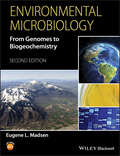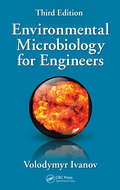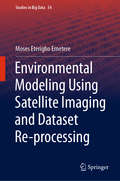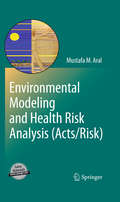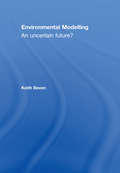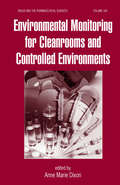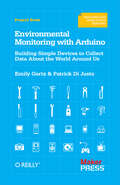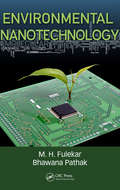- Table View
- List View
Environmental Microbial Biotechnology
by Lala Behari Sukla Nilotpala Pradhan Sandeep Panda Barada Kanta MishraThis book provides a timely review of strategies for coping with polluted ecosystems by employing bacteria, fungi and algae. It presents the vast variety of microbial technologies currently applied in the bioremediation of a variety of anthropogenic toxic chemicals, mining and industrial wastes and other pollutants. Topics covered include: microbe-mineral interactions, biosensors in environmental monitoring, iron-mineral transformation, microbial biosurfactants, bioconversion of cotton gin waste to bioethanol, anaerobe bioleaching and sulfide oxidation. Further chapters discuss the effects of pollution on microbial diversity, as well as the role of microbes in the bioremediation of abandoned mining areas, industrial and horticultural wastes, wastewater and sites polluted with hydrocarbons, heavy metals, manganese and uranium.
Environmental Microbial Evolution: Methods and Protocols (Methods in Molecular Biology #2569)
by Haiwei LuoThis volume explores the latest techniques used to study environmental microbial evolution, with a focus on methods capable of addressing deep evolution at long timescales. The chapters in this book are organized into three parts. Part One introduces molecular dating approaches and time calibration ideas that allow for the determination of evolutionary timescales of microbial lineages. Part Two describes several advanced phylogenomic tools such as models for genome tree construction, a taxon sampling method, outgroup-independent tree-rooting methods, and gene family evolution models. Part Three covers techniques used to study trait evolution. Written in the highly successful Methods in Molecular Biology series format, chapters include introductions to their respective topics, lists of the necessary materials and reagents, step-by-step, readily reproducible laboratory protocols, and tips on troubleshooting and avoiding known pitfalls.Cutting-edge and comprehensive, Environmental Microbial Evolution: Methods and Protocols is a valuable tool for all researchers who are interested in learning more about this important and evolving field.
Environmental Microbiology
by Alan Varnam Malcolm EvansMicro-organisms play a major role in the geochemistry of the planet, forming the basic stage in the food chain, and thus sustaining the existence of higher evolutionary life. The continuing interaction between these living organisms and the environment, combined with their exploitation by man are shaping the material world today.Over the last few y
Environmental Microbiology
by John F. Spencer Alicia L. Ragout de SpencerA collection of readily reproducible techniques for determining most of the important factors governing microorganisms and their habitats. Presented in step-by-step detail, these cutting-edge methods range from those for the study of marine organisms, to those for investigating microorganisms occurring in groundwater, to the biodiversity of yeasts found in remote environments. The novel protocols for studying fermented milks are significant for investigators concerned with milk as an item of food for infants, small children, and even adults. Additional methods for the recovery and determination of nucleic acids and other compounds affecting, and affected by, microorganisms are given for certain enzymes produced by plant pathogens and for obtaining microbial species tolerant of such inhibitors as heavy metals.
Environmental Microbiology
by Ian T. Paulsen Andrew J. HolmesAn up-to-date view of molecular mechanisms for investigating microbial communities and their biological activities, this new volume of "Environmental Microbiology: Methods and Protocols" looks at recent advances that are having a big impact on the field such as metagenomics and other "omics" technologies, NanoSIMS, as well as stable isotope probing and more. Conveniently divided into four parts, the first section looks at methods involved in sampling environmental microorganisms, the second profiles different methods for investigating the diversity and composition of microbial communities, the third focuses on techniques for analyzing biological activities "in situ," and the final section examines high throughput "omics" approaches for the characterization of environmental microbial communities. This book was written as part of the highly successful "Methods in Molecular Biology" series, and, as such, chapters contain introductions to their respective topics, lists of the necessary materials and reagents, step-by-step, readily reproducible laboratory protocols, and tips on troubleshooting and avoiding known pitfalls. Fully updated and authoritative, "Environmental Microbiology: Methods and Protocols, Second Edition" aims to provide an unprecedented glimpse into the structure, composition, and activity of microbial communities across diverse environments and illuminate their impact on global ecological processes.
Environmental Microbiology
by Eugene L. MadsenThis well-referenced, inquiry-driven text presents an up-to-date and comprehensive understanding of the emerging field of environmental microbiology. Coherent and comprehensive treatment of the dynamic, emerging field of environmental microbiology Emphasis on real-world habitats and selective pressures experienced by naturally occurring microorganisms Case studies and "Science and the Citizen" features relate issues in the public's mind to the underlying science Unique emphasis on current methodologies and strategies for conducting environmental microbiological research, including methods, logic, and data interpretation
Environmental Microbiology
by Walter Reineke Michael SchlömannThis textbook addresses global and local environmental problems and the involvement of microorganisms in their development and remediation. In particular, methodological aspects, some of them molecular genetic, for the study of microbial communities are considered. Overall, the prominent role of microorganisms in various material cycles is presented. In addition to biochemical principles for the degradation of environmental pollutants, the use of microorganisms in environmental biotechnological processes for the purification of air, water or soil as well as in environmentally friendly production processes is discussed. The book is intended for biologists with an interest in environmental microbiological issues, but also for students of process or environmental engineering, geoecology or geology, as well as students of other environmental science disciplines. For the 3rd edition, the authors have completely revised, corrected, updated and supplemented the book.
Environmental Microbiology and Biotechnology: Volume 1: Biovalorization of Solid Wastes and Wastewater Treatment
by Anoop Singh Dheeraj Rathore Deepak Pant Shaili SrivastavaThis book provides up-to-date information on the state of the art in applications of biotechnological and microbiological tools for protecting the environment. Written by leading international experts, it discusses potential applications of biotechnological and microbiological techniques in solid waste management, wastewater treatment, agriculture, energy and environmental health. This first volume of the book “Environmental Microbiology and Biotechnology,” covers three main topics: Solid waste management, Agriculture utilization and Water treatment technology, exploring the latest developments from around the globe regarding applications of biotechnology and microbiology for converting wastes into valuable products and at the same time reducing the environmental pollution resulting from disposal. Wherever possible it also includes real-world examples. Further, it offers advice on which procedures should be followed to achieve satisfactory results, and provides insights that will promote the transition to the sustainable utilization of various waste products.
Environmental Microbiology and Biotechnology: Volume 2: Bioenergy and Environmental Health
by Anoop Singh Dheeraj Rathore Deepak Pant Shaili SrivastavaThis book provides up-to-date information on the state of the art in applications of biotechnological and microbiological tools for protecting the environment. Written by leading international experts, it discusses potential applications of biotechnological and microbiological techniques in solid waste management, wastewater treatment, agriculture, energy and environmental health. This second volume of book “Environmental Microbiology and Biotechnology,” covers two main topics: bioenergy and environmental health, exploring the latest developments from around the globe regarding applications of biotechnology and microbiology for converting wastes into valuable products and at the same time reducing the environmental pollution resulting from disposal. Wherever possible it also includes real-world examples. Further, it offers advice on which procedures should be followed to achieve satisfactory results, and provides insights that will promote the transition to the sustainable utilization of various waste products.
Environmental Microbiology and Microbial Ecology
by Larry L. Barton Robert J. McLeanAn authoritative overview of the ecological activities of microbes in the biosphere Environmental Microbiology and Microbial Ecology presents a broad overview of microbial activity and microbes' interactions with their environments and communities. Adopting an integrative approach, this text covers both conventional ecological issues as well as cross-disciplinary investigations that combine facets of microbiology, ecology, environmental science and engineering, molecular biology, and biochemistry. Focusing primarily on single-cell forms of prokaryotes — and cellular forms of algae, fungi, and protozoans — this book enables readers to gain insight into the fundamental methodologies for the characterization of microorganisms in the biosphere. The authors draw from decades of experience to examine the environmental processes mediated by microorganisms and explore the interactions between microorganisms and higher life forms. Highly relevant to modern readers, this book examines topics including the ecology of microorganisms in engineered environments, microbial phylogeny and interactions, microbial processes in relation to environmental pollution, and many more. Now in its second edition, this book features updated references and major revisions to chapters on assessing microbial communities, community relationships, and their global impact. New content such as effective public communication of research findings and advice on scientific article review equips readers with practical real-world skills. Explores the activities of microorganisms in specific environments with case studies and actual research data Highlights how prominent microbial biologists address significant microbial ecology issues Offers guidance on scientific communication, including scientific presentations and grant preparation Includes plentiful illustrations and examples of microbial interactions, community structures, and human-bacterial connections Provides chapter summaries, review questions, selected reading lists, a complete glossary, and critical thinking exercises Environmental Microbiology and Microbial Ecology is an ideal textbook for graduate and advanced undergraduate courses in biology, microbiology, ecology, and environmental science, while also serving as a current and informative reference for microbiologists, cell and molecular biologists, ecologists, and environmental professionals.
Environmental Microbiology for Engineers
by Volodymyr IvanovUpdated Edition Includes a New Chapter and Enhanced Study MaterialThe second edition of Environmental Microbiology for Engineers explores the role that microorganisms play in the engineered protection and enhancement of an environment. Offering a perfect balance of microbiological knowledge and environmental biotechnology principles, it provides a
Environmental Microbiology for Engineers
by Volodymyr IvanovThe third edition of Environmental Microbiology for Engineers explores the role that microorganisms play in the engineered protection and enhancement of an environment. Offering a perfect balance of microbiological knowledge and environmental biotechnology principles, it provides a practical understanding of microorganisms and their functions in the environment and in environmental engineering systems. The book also presents a quantitative description of applied microbiological processes and their engineering design. This updated edition includes all new information on construction biotechnology, biogeotechnical engineering, construction biomaterials, environmental engineering of life-support closed ecosystems, defense biotechnologies, and biosafety in civil and environmental engineering. Features: Classroom tested in universities as a primary course text for civil and environmental engineering students Includes quizzes, problems, and solutions for better understanding of the material Covers essential topics such as the diversity and functions of microorganisms in the environment and environmental engineering systems, the structure and functions of microbial ecosystems, applied microbial genetics and molecular biology, environmental bioengineering, and more Offers combined coverage of microbiology and biotechnology adapted for students in advanced civil and environmental engineering courses Environmental Microbiology for Engineers provides a practical understanding of microorganisms in civil engineering processes and their functions in environmental engineering systems. It is intended for upper-level undergraduate, graduate, and post-graduate students of civil and environmental engineering. It is also useful for practicing environmental engineers working in the areas of wastewater, solid waste treatment, soil remediation, and ground improvement.
Environmental Microbiology of Aquatic and Waste Systems
by Nduka OkaforThis book places the main actors in environmental microbiology, namely the microorganisms, on center stage. Using the modern approach of 16S ribosomal RNA, the book looks at the taxonomy of marine and freshwater bacteria, fungi, protozoa, algae, viruses, and the smaller aquatic animals such as nematodes and rotifers, as well as at the study of unculturable aquatic microorganisms (metagenomics). The peculiarities of water as an environment for microbial growth, and the influence of aquatic microorganisms on global climate and global recycling of nitrogen and sulphur are also examined. The pollution of water is explored in the context of self-purification of natural waters. Modern municipal water purification and disease transmission through water are discussed. Alternative methods for solid waste disposal are related to the economic capability of a society. Viruses are given special attention. By focusing on the basics, this primer will appeal across a wide range of disciplines.
Environmental Microbiology: From Genomes to Biogeochemistry
by Eugene L. MadsenThis well-referenced, inquiry-driven text presents an up-to-date and comprehensive understanding of the emerging field of environmental microbiology. Coherent and comprehensive treatment of the dynamic, emerging field of environmental microbiology Emphasis on real-world habitats and selective pressures experienced by naturally occurring microorganisms Case studies and “Science and the Citizen” features relate issues in the public’s mind to the underlying science Unique emphasis on current methodologies and strategies for conducting environmental microbiological research, including methods, logic, and data interpretation
Environmental Microbiology: Fundamentals and Applications
by Jean-Claude Bertrand Pierre Caumette Philippe Lebaron Robert Matheron Philippe Normand Télesphore Sime-NgandoThis book is a treatise on microbial ecology that covers traditional and cutting-edge issues in the ecology of microbes in the biosphere. It emphasizes on study tools, microbial taxonomy and the fundamentals of microbial activities and interactions within their communities and environment as well as on the related food web dynamics and biogeochemical cycling. The work exceeds the traditional domain of microbial ecology by revisiting the evolution of cellular prokaryotes and eukaryotes and stressing the general principles of ecology. The overview of the topics, authored by more than 80 specialists, is one of the broadest in the field of environmental microbiology. The overview of the topics, authored by more than 80 specialists, is one of the broadest in the field of environmental microbiology.
Environmental Modeling Using Satellite Imaging and Dataset Re-processing (Studies in Big Data #54)
by Moses Eterigho EmetereThis book introduces methods of re-processing images to extract numerical information that can be used to quantify the observables in environmental modelling. Experiments or procedures that yield large images can be statistically or parametrically examined. Through the use of open source libraries, the book shows how ‘big data’ in the form of images or datasets can be comparatively analysed along same defined procedures or standards. This book helps to solve the challenges of discarding datasets that are relevant directly or indirectly to the research. The habit of screening datasets leads to the discard of over 90% of the original dataset or images generated in the experiments or procedure. If the images or datasets are generated under the same principles or conditions, then each measurement may be the narrative of unique events. The focus of this book is to enlighten researchers on how to analyse measurements with the aim of ensuring 100% utilization.
Environmental Modeling and Health Risk Analysis (Acts/Risk)
by Mustafa M. AralThis book is intended to serve as a comprehensive source for the advancements and contributions made in environmental transformation and transport modeling in general and the associated health risk assessment topics in particular. The selection of the title, "Environmental Modeling and Health Risk Analysis" stems from an ambitious objective of providing a review of air, surface water and groundwater quality modeling topics and linking these models with exposure and health risk analysis. Thus, the purpose is to provide the reader with an integrated perspective on these two seemingly distant fields. The ACTS and RISK software that is an integral part of this book include computational platforms for all models discussed in the book. Using these two software tools, available from http://extras.springer.com/ , the models described in the book can be readily accessed and used in classroom or professional applications as demonstrated in the book.
Environmental Modelling: An Uncertain Future?
by Keith BevenUncertainty in the predictions of science when applied to the environment is an issue of great current relevance in relation to the impacts of climate change, protecting against natural and man-made disasters, pollutant transport and sustainable resource management. However, it is often ignored both by scientists and decision makers, or interpreted as a conflict or disagreement between scientists. This is not necessarily the case, the scientists might well agree, but their predictions would still be uncertain and knowledge of that uncertainty might be important in decision making. Environmental Modelling: An Uncertain Future? introduces students, scientists and decision makers to: the different concepts and techniques of uncertainty estimation in environmental prediction the philosophical background to different concepts of uncertainty the constraint of uncertainties by the collection of observations and data assimilation in real-time forecasting techniques for decision making under uncertainty. This book will be relevant to environmental modellers, practitioners and decision makers in hydrology, hydraulics, ecology, meteorology and oceanography, geomorphology, geochemistry, soil science, pollutant transport and climate change. A companion website for the book can be found at www.uncertain-future.org.uk
Environmental Monitoring
by G. Bruce WiersmaThe current rate and scale of environmental change around the world makes the detection and understanding of these changes increasingly urgent. Subsequently, government legislation is focusing on measurable results of environmental programs, requiring researchers to employ effective and efficient methods for acquiring high-quality data. Focusing on pollution issues and impacts resulting from human activities, Environmental Monitoring is the first to bring together the conceptual basis behind the complex and specific approaches to the monitoring of air, water, and land. Coverage includes integrated monitoring at the landscape level, as well as case studies of existing monitoring programs such as the Chesapeake Bay Program. The book also addresses the recent legislative focus on high-quality data results and conducting monitoring programs in different ecosystems and environmental media.
Environmental Monitoring for Cleanrooms and Controlled Environments (Drugs and the Pharmaceutical Sciences)
by Anne Marie DixonA critical technology in the science of contamination control, environmental monitoring is a technique that provides important data on the quality of a process, processing environment, and final product, which can aid scientists in identifying and eliminating potential sources of contamination in cleanrooms and controlled environments. In response
Environmental Monitoring of Bacteria
by Clive EdwardsClive Edwards and his distinguished panel of researchers bring together a collection of detailed molecular methods for the environmental monitoring of bacterial populations. These state-of-the-art methods include techniques for the recovery of cells, for the analysis of whole cells, and for the molecular study of target species and heterogeneous populations. Many of the methods enable bacteria to be monitored in their natural environments without culturing and specifically address the difficult problem that only a small proportion of bacteria in any ecosystem can be cultured by traditional microbiological methods. Environmental Monitoring of Bacteria takes full advantage of the exciting research in recent years that has challenged some long-held principles of traditional microbiology and gives timely and practical access to techniques that allow the study of bacterial ecology as communities, single cells, or at the molecular level.
Environmental Monitoring with Arduino: Building Simple Devices to Collect Data About the World Around Us
by Emily Gertz Patrick Di JustoAfter the devastating tsunami in 2011, DYIers in Japan built their own devices to detect radiation levels, then posted their finding on the Internet. Right now, thousands of people worldwide are tracking environmental conditions with monitoring devices they’ve built themselves. You can do it too!This inspiring guide shows you how to use Arduino to create gadgets for measuring noise, weather, electromagnetic interference (EMI), water purity, and more. You’ll also learn how to collect and share your own data, and you can experiment by creating your own variations of the gadgets covered in the book. If you’re new to DIY electronics, the first chapter offers a primer on electronic circuits and Arduino programming.Use a special microphone and amplifier to build a reliable noise monitorCreate a gadget to detect energy vampires: devices that use electricity when they’re “off”Examine water purity with a water conductivity deviceMeasure weather basics such as temperature, humidity, and dew pointBuild your own Geiger counter to gauge background radiationExtend Arduino with an Ethernet shield—and put your data on the InternetShare your weather and radiation data online through Pachube
Environmental Nanotechnology
by Bhawana Pathak M. H. FulekarEnvironmental nanotechnology is considered to play a key role in shaping of current environmental engineering and science practices. This book titled "Environmental Nanotechnology" covers the advanced materials, devices, and system development for use in the environmental protection. The development of nano-based materials, understanding their chemistry and characterization using techniques like X- Ray diffraction, FT-IR, EDX, scanning electron microscope (SEM), transmission electron microscope (TEM), high resolution-TEM, etc is included. It also highlights the scope for their applications in environmental protection, environmental remediation and environmental biosensors for detection, monitoring and assessment. Key Features: Covers basic to advanced Nano-based materials, their synthesis, development, characterization and applications and all the updated information related to environmental nanotechnology. Discusses implications of nanomaterials on the environment and applications of nanotechnology to protect the environment. Illustrates specific topics such as ethics of nanotechnology development, Nano-biotechnology, and application in wastewater technology. Includes applications of nanomaterials for combating global climate change and carbon sequestration. Gives examples of field applications of environmental nanotechnology. This book covers advanced materials, devices, and system developments for use in environmental protection. The development of nano-based materials, understanding its chemistry and characterization by the use of X-Ray diffraction, FT-IR, EDX, scanning electron microscope (SEM), transmission electron microscope (TEM), and high resolution-TEM give the scope for their application in environmental protection, environmental remediation, and environmental biosensors for detection, monitoring, and assessment. The green chemistry based on nano-based materials prevents pollution and controls environmental contaminants.
Environmental Nanotechnology Volume 3 (Environmental Chemistry for a Sustainable World #27)
by Eric Lichtfouse Shivendu Ranjan Nandita DasguptaThis third volume on environmental nanotechnology includes chapters dealing with topics such nanoremediation, waste water purification, nanosensors, nanomedicine, and nanofiltration. It also highlights the safety aspects and risk assessment and management related to several toxins, as well as nanotechnology related solutions for these challenges. The book also discusses new nanomaterials from the nexus of environment, water, remediation and total environment.
Environmental Nanotechnology Volume 4 (Environmental Chemistry for a Sustainable World #32)
by Eric Lichtfouse Shivendu Ranjan Nandita DasguptaThis book presents comprehensive reviews on the latest developments of nanotechnologies to detect and remove pollutants in water, air and food. Polymer nanocomposites, nanoparticles from microbes and application of nanotechnologies for desalination and agriculture are also addressed. Pollution of water and air by contaminants and diseases is a major health issue leading globally to millions of deaths yearly, according to the World Health Organization, and such an issue requires advanced methods to clean environmental media.





